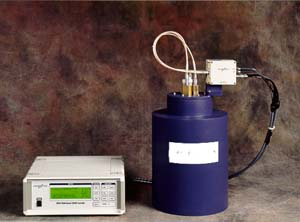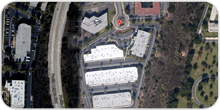HTS Geo systems 77K see Geo systems pdf
T877 Tensor data sheet (77K) see Tensor pdf:
SMM-401 nanoSQUID (4K) see SMM-401 pdf
DRM-300 data sheet Cryocooled Rock Magnetometer (4K) DRM-330 pdf
Please contact ASC Scientific http://www.ascscientific.com/ for additional details on the DRM-300 and accessories.
SQUID Magnetometers
Tristan offers a wide variety of SQUID magnetometers for geophysical measurements. For exploration, Tristan offers a line of HTS SQUID magnetometer systems using liquid nitrogen as a refrigerant for reduced cost and portability. For the ultimate in sensitivity, Tristan also offers LTS systems that use either liquid helium or mechanical refrigeration.
The use of SQUIDs in electromagnetic prospecting methods can be divided into passive (e.g., magnetotellurics – MT, Audio MT – AMT, and magnetic anomaly detection – MAD) and active methods (e.g., transient electromagnetics – TEM) or frequency (e.g., controlled source audio magnetotellurics – CSAMT)
Passive Measurements
 For measurements of external fields, SQUID magnetometers can be used to measure the Earth’s magnetic field at frequencies ranging between 10-4 Hz and 1 kHz. In comparison to large induction coils, SQUID magnetometers are easier to deploy and use (allowing SQUID sensors to be placed down boreholes), operate to dc (with flat phase response) and avoid giving undue emphasis to high frequency phenomena such as the ubiquitous lightning-induced sferics. Their wide bandwidth allows the use of a single instrument as compared to induction coils where multiple coils may be required. The high dynamic range of SQUIDs can allow diurnal range variations (± 100 nT) to be tracked while still maintaining full sensitivity.
For measurements of external fields, SQUID magnetometers can be used to measure the Earth’s magnetic field at frequencies ranging between 10-4 Hz and 1 kHz. In comparison to large induction coils, SQUID magnetometers are easier to deploy and use (allowing SQUID sensors to be placed down boreholes), operate to dc (with flat phase response) and avoid giving undue emphasis to high frequency phenomena such as the ubiquitous lightning-induced sferics. Their wide bandwidth allows the use of a single instrument as compared to induction coils where multiple coils may be required. The high dynamic range of SQUIDs can allow diurnal range variations (± 100 nT) to be tracked while still maintaining full sensitivity.
Magnetotellurics has been used for oil exploration in the overthrust belts of the western United States and deep sediments of the Gulf coast region. The increased conductivity of hot saline regions associated with geothermal sites makes MT well suited for locating hydrothermal reservoirs. Tristan’s model G377 3-axis (Bx, By, Bz) 77K Geophysical Magnetometer SQUID System [see HTS Geo Syst ems.pdf ] is specifically designed for MT and other passive measurements. It offers high sensitivity (better than 100 fT/√Hz), wide bandwidth (dc – 10+ kHz), and flat phase response. Its light weight and long hold time make it a convenient instrument for any measurements of geomagnetic fields. Tristan can supply variants of the G377 specifically designed for borehole use (shallow and deep applications) or airborne use.
Optional Dewars


Output of HTS planar gradiometer flying over a commercial vehicle (arbitrary units). The gradiometer was inside a tail mounted stinger on a Cessna Caravan airplane. Courtesy ~ Sky Research.
Another passive detection method is magnetic anomaly detection (MAD). By knowing the total magnetic field gradient tensor(MGT) of an object, it is possible to determine the magnitude and direction of a magnetic source. Tristan’s T877 8-element tensor gradiometer system [see T877.pdf] was specifically designed for magnetic anomaly measurements.
Active Measurements
Active methods typically create a time dependent magnetic field generated by a loop driven with an electric current, with the magnetometer detecting the induced field. Measurements can either be in the time (e.g., transient electromagnetics (TEM)) or frequency (e.g., controlled source audio magnetotelluric(CSAMT)) domain.
Typically, TEM uses large excitation coils to generate magnetic pulses. Pulse lengths can range from 1 µsec up to 1 sec. The magnetic fields generated by the loop can be measured with a three-axis magnetometer or an 8-element vector/tensor array such as the Tristan T877 Tensor gradiometer. The advantage of the 8-element vector/tensor array is its ability to spatially locate the object being excited by the electromagnetic pulse. The figure below shows TEM measurements taken with a Tristan T877 of the five independent tensor gradients over a 10 cm diameter hollow (30 mil thick) copper sphere.

Rock Magnetometry
Knowledge of the magnetic field orientation and magnetization (moment) of a rock or core sample can give information as to how the rock was formed and information as to its constituents. Tristan’s model DRM-300 rock magnetometer [ see DRM-300 data sheet v.1.pdf ] is a compact and easy to use SQUID magnetometer system for measurement of remnant magnetization of geophysical samples. The use of closed cycle refrigeration eliminates the need to transfer liquid helium and minimizes the cost of consumables. Its small footprint minimizes laboratory space. The DRM-300 simultaneously measures all three moment vectors (Mx, My, Mz) with sensitivity down to 10-12 A-m2. Please contact ASC Scientific http://www.ascscientific.com/ for additional details on the DRM-300 and accessories

Paleomagnetism
SQUID microscopes can also be used to image magnetization in slices taken from rock samples with sub-mm spatial resolution. This can yield highly detailed maps with the ability to resolve a single grain in a rock. Tristan’s model SMM-401 [see SMM-401 v0.2.pfd] is a powerful non-contact, scanning microscopy for imaging magnetic field distributions. The SMM-401 offers unparalleled spatial resolutions (better than 100 µm) and moment sensitivities (better than 10-15 A-m2). Please contact ASC Scientific http://www.ascscientific.com/ for additional details on the SMM-401 and accessories.
Custom Systems
Tristan can also supply custom Geophysical measurement systems to meet virtually any need. Contact Tristan for further information.


